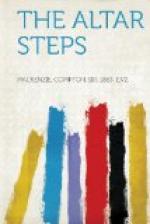Mark who had been thinking what an easy affair life must be for Sir Charles was struck by his tone of disillusionment. Perhaps all people who inherited old names and old estates were affected by their awareness of transitory possession. Sir Charles could not alienate even a piece of furniture. A middle-aged bachelor and a cosmopolitan, he would have moved about the corridors and halls of that huge house with less permanency than Lord Middlesborough who paid him so well to walk about in it in his stead, and who was no more restricted by the terms of his lease than was his landlord by the conditions of the entail. Mark began to feel sorry for him; but without cause, for when Sir Charles came in sight of Malford Lodge where he lived, he was full of enthusiasm. It was indeed a pretty little house of red brick, dating from the first quarter of the nineteenth century and like so many houses of that period built close to the road, surrounded too on three sides by a verandah of iron and copper in the pagoda style, thoroughly ugly, but by reason of the mellow peacock hues time had given its roof, full of personality and charm. They entered by a green door in the brick wall and crossed a lawn sloping down to the little river to reach the shade of a tulip tree in full bloom, where seated in one of those tall wicker garden chairs shaped like an alcove was an elderly lady as ugly as Priapus.
“There’s Lady Landells, who’s a poetess, you know,” said Sir Charles gravely.
Mark accepted the information with equal gravity. He was still unsophisticated enough to be impressed at hearing a woman called a poetess.
“Mr. Lidderdale is going to have lunch with us, Lady Landells,” Sir Charles announced.
“Oh, is he?” Lady Landells replied in a cracked murmur of complete indifference.
“He’s a great admirer of your poems,” added Sir Charles, hearing which Lady Landells looked at Mark with her cod’s eyes and by way of greeting offered him two fingers of her left hand.
“I can’t read him any of my poems to-day, Charles, so pray don’t ask me to do so,” the poetess groaned.
“I’m going to show Mr. Lidderdale some of our pictures before lunch,” said Sir Charles.
Lady Landells paid no attention; Mark, supposing her to be on the verge of a poetic frenzy, was glad to leave her in that wicker alcove under the tulip tree and to follow Sir Charles into the house.
It was an astonishing house inside, with Gothic carving everywhere and with ancient leaded casements built inside the sashed windows of the exterior.
“I took an immense amount of trouble to get this place arranged to my taste,” said Sir Charles; and Mark wondered why he had bothered to retain the outer shell, since that was all that was left of the original. In every room there were copies, excellently done of pictures by Botticelli and Mantegna and other pre-Raphaelite painters; the walls were rich with antique brocades and tapestries; the ceilings were gilded or elaborately moulded with fan traceries and groining; great candlesticks stood in every corner; the doors were all old with floriated hinges and huge locks—it was the sort of house in which Victor Hugo might have put on his slippers and said, “I am at home.”




